Car Buffers
Why you likely don't know enough to even ask the right questions
Car buffers and car polishing is an area of auto detailing filled with way too much bad information!
If you are new to the world of paint polishing and car buffing, get ready to chase your tail as this is a topic filled with tons of hype, misused terminology, and endless opinions.
As an auto detailing expert from the actual world of professional detailing, I am going to take my years of experience and make an informed consumer out of you!
If you are willing to put some time into this topic you will know more about car buffers than most "professional detailers" I meet along my travels.
Understanding the Random Orbital Buffer (Dual Action)
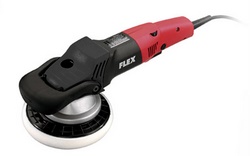
Also called dual action polishers (DA for short), these fail-safe buffers are not only a starting point for beginners, but the finishing tool for advanced car polishers.
As the name implies, these polishers operate using two different motions and are considered the safest buffer and therefore become the best buffer for any beginner.
The orbital polisher was designed to duplicate the action of your hand applying wax to a car. You can think the iconic scene from the movie Karate Kid of "wax on, wax-off".
The dual action has two independent moving or rotating points. It is helpful to make a comparison to the earth's spinning rotation —movement 1(this gives us the 24 hour day) and movement 2 —the earth as it circles the sun (which gives us a year).
Orbital buffers operate at lower RPM's relative to the high speed buffers.
The rotary buffer (high speed buffer) spins on a single axis point and have tons of power. The way these buffers are engineered makes them very efficient at getting work done, but also requires a longer learning curve to operate them safely when performing paint correction.
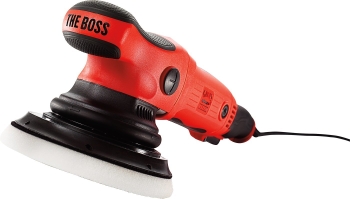
Forced and Random Orbital Buffers
When it comes to dual action (DA) buffers, there are essentially two versions you can choose from:
1) Random Orbital Buffer: A random orbital buffer is safer than a rotary polisher due to its free-floating spindle assembly. This design features a spindle on a bearing that spins when the machine is on. The polishing head both spins and vibrates during use, but applying enough downward pressure stops the spinning, leaving only vibration. This intentional mechanism makes random orbital buffers effective and exceptionally safe, as the lack of continuous spinning reduces the risk of surface damage. The "random" name comes from the dual-axis motion, which creates an unpredictable, non-repetitive pattern for even polishing.
2) Forced Rotation Buffer: Forced rotation DA car buffers are less common and offer fewer options than random orbital buffers. Though favored by some top professionals, they are harder to control. Unlike random orbital buffers, their gear-driven spindles keep both spinning and rotating even under pressure, making them less forgiving. While safer than rotary polishers, they remain less popular, as the industry has embraced high-quality random orbital buffers, which better suit most users. (For this reason, I don’t review forced rotation DA car buffers.)
Darren's Note:
Hand-polishing cars is nearly extinct, yet some still claim it’s the best method. However, every modern industry relies on power tools to achieve better results and far greater efficiency than hand polishing can offer.
Reasons why a few continue to reject and criticize power buffers for car polishing include:
- They’ve never used a car polisher.
- They resist adopting new technology.
- They appeal to a small group with similar outdated views.
- They’re stubborn, dismissing clear evidence supporting alternative methods.
High Speed Buffer
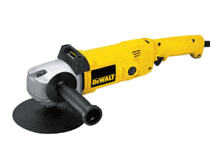
The "infamous" high-speed buffer, officially a rotary buffer, has a bad reputation for creating swirl marks, buffer tracks, and burning edges.
However, the issue lies with the user, not the buffer itself. Unlike orbital buffers, rotary buffers are straightforward, spinning on a single axis at high speeds, typically adjustable from 600 to 2800 RPM. They deliver immense torque and won’t stall under heavy pressure.
Reasons for their notoriety include:
- Misuse by operators causing swirl marks or buffer tracks.
- Improper technique leading to burnt edges.
- High-speed, high-torque design requiring skill to control.
The newest advances in DA or random orbital car buffer allow you to get by without ever having to touch a rotary polisher, never mind actually become proficient in using one.
The Simplified Answer:
A rotary polisher powers through tough paint correction tasks that random orbital buffers require much more time to handle —due to the high RPMs and direct drive.
Rotary buffers tackle severe paint damage, wet-sanding marks, or oxidation on boats and RVs with with better efficiency. However, like anything, it comes with trade-offs. For beginners, I recommend starting with a high-quality DA car buffer listed below. Professionals like myself often use both tools: a rotary for heavy lifting and a random orbital for fine-tuning.
Key points:
- Rotary polishers excel at heavy paint correction due to high RPMs and direct drive.
- They remove severe defects, wet-sanding marks, and oxidation more efficiently.
- Professionals use rotary for tough jobs and random orbital for final “jeweling.”
- Beginners should opt for user-friendly DA buffers to start.
The Pros and Cons of Rotary Polishers:
|
Pros:
|
Cons:
|
Darren's Side Note:
The newest generation of rotary car polishers now have incredibly low start/operating speeds. They will all be what is called variable speed polishers; which mean you can not only adjust the speed at the dial, but you can adjust the speed at the trigger. As a rule, all the newest rotary's will start and operate at a very low 600 RPM speed. Traditional polishing with these machines will happen at the 1200-2800 RPM range even though they will typically go to 3200 RPM's. And because of this very low 600 RPM speed, these rotary polishers become incredibly safe.
And while you are here looking among the best car buffers, you will also want to check out my professional opinion on the best car polish.
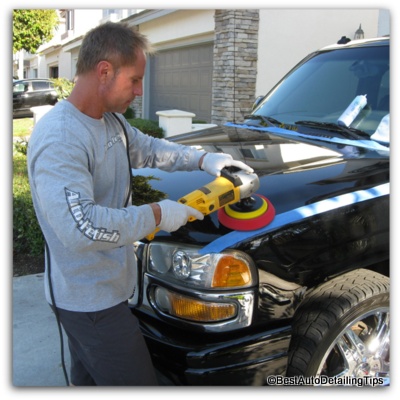
Random orbital buffers are so safe to the point where you would have to purposely try and damage the car paint. And now that I have introduced this "side bar" of info, many of you will begin to wonder if you should perhaps entertain the idea of jumping into a rotary from the beginning. Which is a valid observation. I professionally can take one of these new high-speed polishers, do all the heavy lifting with the right speed, pad, and compound. Change the speed, pad, and polish, and finish the paint to perfection. All doing so in a fraction of the time of a DA buffer only. See this boat polisher link if you are considering this: Boat Polisher
Additional Key Points for Car Buffers
Technology has revolutionized car buffers, just as it has every other field, offering a range of top-notch options. After years of hands-on experience, I’ve learned that a buffer’s “personality”—its feel, balance, and quirks—matters as much as its performance. While any high-quality car buffer can deliver stellar results, the best choice boils down to the user experience that suits you most.
Key points:
- Advanced technology has elevated the quality and variety of car buffers.
- A buffer’s unique “feel” becomes critical with experience.
- User experience is the deciding factor among high-performing buffers.
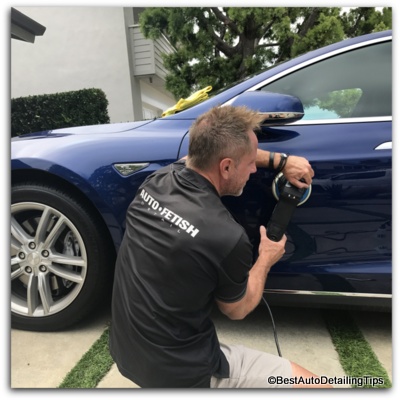
Choosing the right car buffer involves evaluating several key factors to ensure it meets your needs.
Key considerations:
- Cost: What is the price of the buffer?
- Availability: How easily can it be purchased?
- Weight: How heavy is the buffer?
- Noise: How loud is the polisher during operation?
- Ergonomics: How does the polisher feel in your hands?
- Warranty reputation: What is the company’s track record for honoring warranties? (A warranty is only as good as the company behind it.)
Buffing Kits To Simplify Your Life
After diving into the world of rotary, forced rotation DA, and random orbital car buffers, it’s evident that random orbital car buffers offer the ideal mix of safety, performance, and user-friendliness for most enthusiasts. Rather than just grabbing a standalone car buffer, I highly recommend choosing a complete polishing kit to kickstart your car polishing adventure. These kits save both time and money while equipping you with all the essentials for professional-quality results right out of the gate.
Why polishing kits with car buffers are the way to go:
- Cost-effective: Kits bundle your car buffer with vital tools, pads, and polishes at a lower cost than purchasing each item separately.
- Time-saving: Everything needed for polishing is included, sparing you the effort of hunting down compatible components for your car buffer.
- Compatibility: Kits are designed with pads and polishes that pair perfectly with the included car buffer for optimal performance.
- Beginner-friendly: Many kits come with guides or instructions, helping newcomers use their car buffer with confidence.
- Versatility: Kits often provide a variety of pads and compounds, allowing your car buffer to handle tasks from heavy paint correction to delicate jeweling.
Griot's Garage G9 Polishing Kit
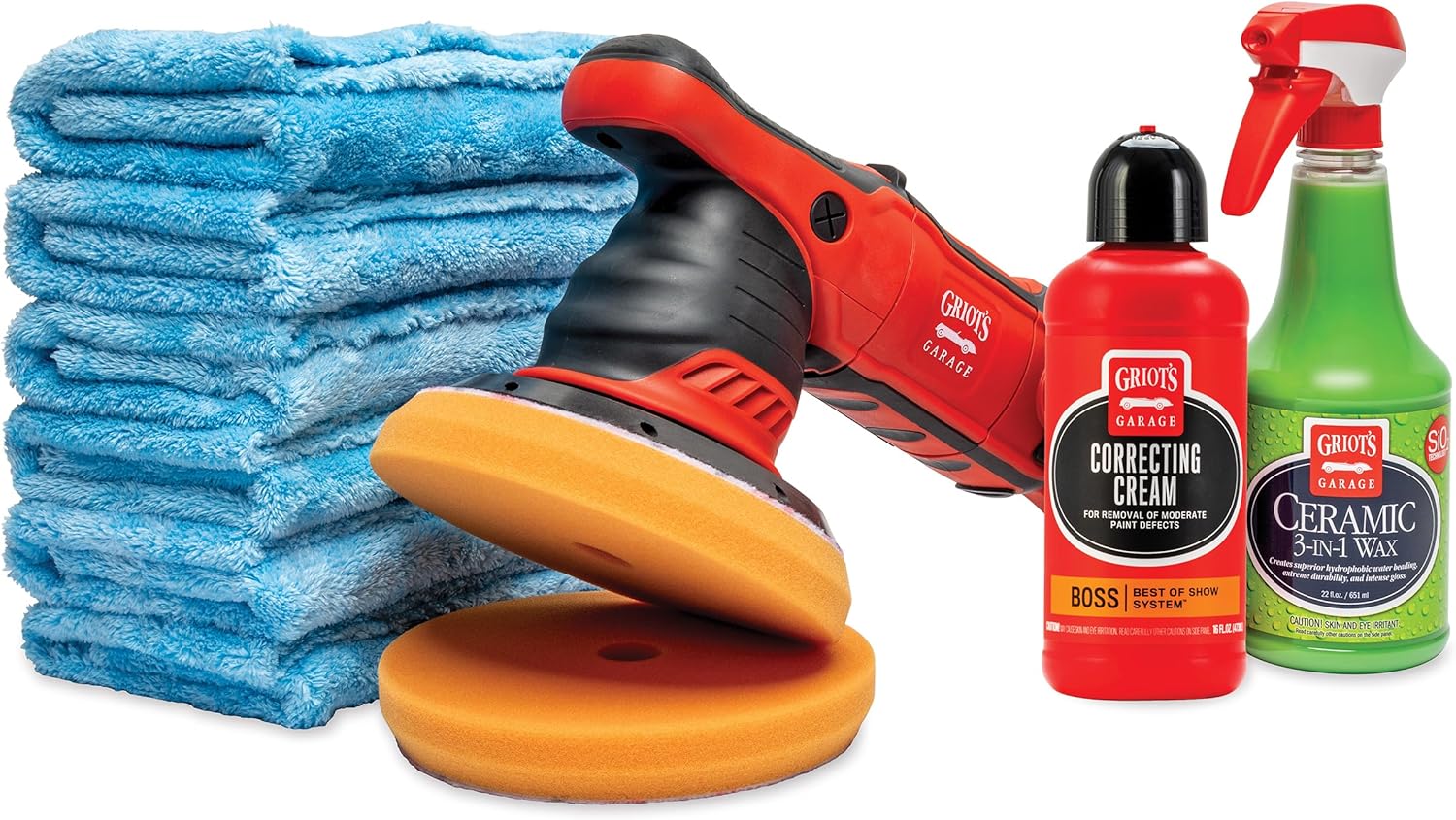
Griot's G9 Ceramic Car Polishing Kit on Amazon
Revitalize your car's finish effortlessly with this comprehensive polishing kit:
- Complete Polishing Kit: Includes a powerful G9 Random Orbital Polisher, BOSS Correcting Cream, two 6.5" Orange Foam Correcting Pads, six plush Microfiber Edgeless Towels, and Ceramic 3-in-1 Wax.
- Superior Detailing Power: The G9 polisher provides effective paint correction, paired seamlessly with BOSS Correcting Cream to eliminate moderate to severe paint defects, topped off by Ceramic 3-in-1 Wax for lasting shine and protection.
- Advanced Ceramic Protection: Water-resistant 3-in-1 Ceramic Wax enriched with advanced polymers and SiO₂ technology guards against UV damage, stains, and surface etching, while its self-cleaning formula minimizes dust and dirt accumulation.
- Durable Foam Pads: Orange Foam Correcting Pads feature a flat, beveled design ensuring even product distribution, effortless application, enhanced durability, and machine-washable convenience for long-term reliability.
- Gentle, Scratch-Free Finish: Set of six Microfiber Plush Edgeless Towels designed with a soft, borderless structure that safely glides over delicate surfaces, delivering a flawless finish free from scratches and streaks.
TORQ Polishing Kit
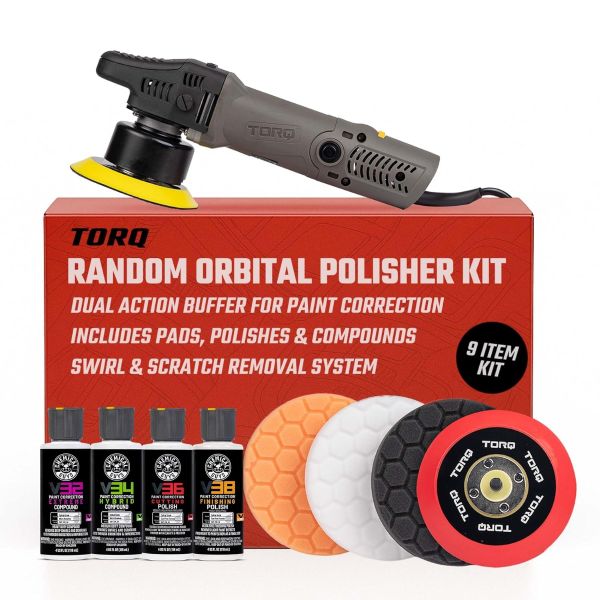
Torq DA Polishing Kit on Amazon
Experience professional-quality car detailing right from your own garage with the versatile TORQX polishing kit:
- Complete All-in-One Solution: The TORQX Kit provides everything you need to polish your paint, remove swirls, scratches, oxidation, and imperfections, restore headlight clarity, and clean glass surfaces. It offers a universal fit, making it ideal for every vehicle.
- Perfect for Pros and Enthusiasts: Designed with both professionals and beginners in mind, the TORQX dual-action polisher combines ease-of-use, lightweight handling, and versatility. Effortlessly tackle paint correction, swirl removal, polishing, and maintain a pristine, showroom-quality shine.
- Powerful Performance: Equipped with a robust 700-watt motor, an 8mm dual-action orbital throw, ergonomic grip, and compact design, the TORQX delivers consistent, powerful results. Its efficient performance ensures minimal fatigue, ideal for extended detailing projects.
- Compact & Highly Versatile: The TORQX features intuitive controls, rugged components, and durable build quality for lasting reliability. Effortlessly handle single-stage paint, clear coats, polished metals, glass, headlights, and taillights, ensuring optimal detailing across multiple surfaces.
- Ideal Gift for Car Enthusiasts: Delight car lovers with the Chemical Guys TORQX Kit—a comprehensive detailing solution for cars, trucks, SUVs, and more. Packed with powerful polishing tools, premium pads, and high-quality compounds, this kit ensures every vehicle looks flawless and stays protected.
Adams's 15mm Swirl Killer Polishing Kit
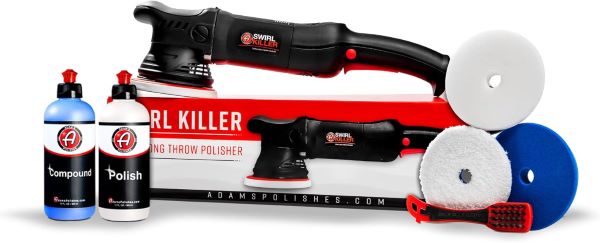
Adam's 15mm Swirl Killer Polishing Kit on Amazon
Elevate your detailing experience with Adam’s Swirl Killer 15 mm Polishing Kit, a comprehensive solution designed to effortlessly remove paint imperfections and restore a flawless finish:
- Complete Detailing Solution: Includes the powerful Swirl Killer dual-action polisher, compound and polish (12 oz each), two 5.5" white foam pads, two 5.5" blue foam pads, two microfiber cutting pads, microfiber towels, detail spray, a Swirl Finder flashlight, pad conditioning brush, and detailing tape—everything you need for flawless paint restoration.
- Powerful, Efficient Performance: The robust 700-watt motor and 15 mm orbital throw deliver fast and safe swirl and scratch removal, matching the efficiency of professional rotary buffers but with greater safety and ease of use.
- Comfort-Focused Design: Designed to minimize fatigue during extended detailing sessions, featuring a soft-start trigger, large lockable switch, anti-vibration rubber grips, and a generous 25-foot flexible power cord.
- Safe & Versatile Correction: The included compound, polish, foam, and microfiber pads allow you to effortlessly move from aggressive defect removal to fine finishing, leaving your paint flawless and free of holograms or marks.
- Professional-Level Accessories: Enhance your detailing precision with included extras such as the Swirl Finder flashlight for detecting imperfections, a pad cleaning brush, quality microfiber towels, and detailing tape for ultimate precision and protection.
Things to Consider When Shopping Car Buffers
Choosing your first car buffer can feel overwhelming, especially with so many options out there—but it doesn’t have to be. Here’s why:
- You Don’t Need to Overthink Your First Choice: While I haven’t tested every single polisher on the market, I’ve used more than I can count—and most perform well enough for beginners. The key is simply getting started.
- You’ll Eventually Upgrade (and That’s Okay): If you keep polishing your own cars or dive into part-time or full-time detailing, you will end up buying more polishers down the road. It’s part of the journey.
- This Makes Your First Choice Easier: Since you're likely to add more tools to your collection over time, your first buffer doesn't need to be your last—or even perfect. Don’t let decision paralysis hold you back.
- Let’s Be Honest—You’ll Want More Anyway: Just like many women love shoes or handbags, most guys can’t resist collecting tools. Even if you don’t need another buffer, you’ll probably buy one just because—buffers are cool!
Polishing Tips for Beginners
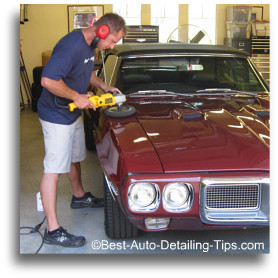
Let’s start with the truth—car polishing and the use of buffers is one of the most misunderstood parts of auto detailing.
Misinformation runs rampant, especially online, where forums are flooded with self-proclaimed “experts” repeating bad advice. After 30+ years of professional experience, I’ve seen it all—and now I’m here to cut through the noise with clarity and real-world insight. Here’s what you need to know as we dive into the polishing process and how buffers really fit into the picture:
- Polishing Is Polishing—No Matter the Material: Whether it’s car paint, granite, diamonds, or wood, the fundamental process of polishing is the same. It all comes down to abrasion.
- Abrasives Are Essential: True polishing requires something abrasive—sandpaper, compounds, polishing pads, even beach sand if you really wanted. The point is: abrasives are the key to smoothing out imperfections.
- You're Literally Scratching Your Way to Perfection: Polishing removes surface defects by replacing them with smaller and smaller scratches—until those scratches become invisible to the naked eye. (Under a microscope, they’re still there.)
- Most Beginners Don’t Actually Remove Scratches: What many people are doing is masking the scratches, not removing them. At best, they’re softening the edges to make them less noticeable.
- Even Pros Often Get It Wrong: Many detailers—and certainly most DIYers—don’t fully understand what it takes to create a truly flawless finish. It involves the right combo of aggressive pads, strong compounds, and plenty of polishing.
- True Perfection Isn’t Always the Goal: While it's possible to achieve a flawless finish, it's often unnecessary—and even impractical—for daily drivers. That level of correction is better suited for show cars, not vehicles exposed to regular wear and tear.
- Satisfaction Comes in the Process: Most people won’t completely remove every scratch, and that’s perfectly fine. Buffing your car can still deliver a huge boost in appearance. More importantly, it’s deeply satisfying—both emotionally and visually—even if it’s your first time behind a buffer.
Darren's Important Tip: Don't skip the decontaminating process. This is the process of using a clay bar to prepare the paint surface PRIOR to polishing. I promise you will want to perform this step as it is critical to both your final results as well as the actual polishing process —or what you might call the user experience as you are polishing.
Pay "Car Buffers" Forward
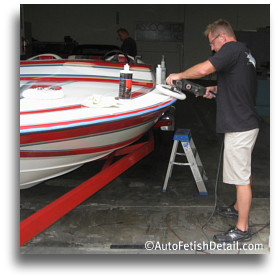
Thanks for checking out my car buffer review! Whether you’re just getting started or you’ve been detailing for years, I hope it gave you some real value. Now that you’ve got a solid grip on choosing the right buffer, be sure to check out my guide on selecting the best car wax to seal the deal and finish strong.
Chances are, you know someone who could benefit from this info—a friend, a family member, a fellow car club member, or someone on your favorite forum. Do them (and me) a solid by sharing it! Whether it’s a quick post on Facebook, a tweet, a forum drop, or just sending the link directly, it helps spread the word.
And to make it super easy, there’s a “Socialize It” button box waiting at the bottom of the page. Pay it forward—someone’s next great detail could start with your share!
Sincerely,
Darren Priest
- Home
- Auto Buffer
- This Page
|
|

